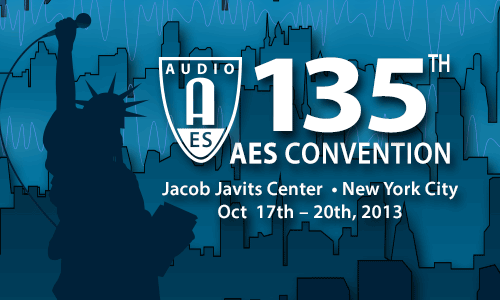
For Release: October 14, 2013
The Audio Engineering Society Marks Its 65th Anniversary at the 135th AES Convention
— Organization looks back, reflecting on its involvement in the major technological and creative breakthroughs of the last seven decades, and prepares for the future of professional audio —
New York, NY — The Audio Engineering Society (AES) was formed on March 11, 1948, with the purpose of uniting the audio engineering community; collecting, collating and disseminating scientific knowledge in audio and its allied arts; and creating literature and periodicals relative to these purposes and policies. Since its formation, the organization has been involved in every key development in professional audio technology. The very year the organization was founded saw the introduction of the microgroove 33-1/3 rpm long-play vinyl record (LP) by Columbia Records, Scotch’s type 111 and type 112 acetate-base tapes, and Magnecord’s PT-6, the first tape recorder in a portable case. This year’s 135th Audio Engineering Society Convention (Thursday, October 17, through Sunday, October 20, 2013, at the Javits Center in New York City) will celebrate that history and witness more history in the making.
The AES was there for each of the true milestones in audio, including the introduction of the 45 rpm, large-hole, 7-inch record (1949), surround sound (1953), "Sel-Sync" overdubbing (1955), Dolby’s Type A noise reduction (1965), the development of digital audio recording (1975-1980), the proposed MIDI standard (1981), the launch of the CD (1982), the arrival of Digidesign’s Sound Tools, the forerunner to Pro Tools (1987), and 24-bit/96 kHz recording (1996). The list goes on, including the introduction of seminal technologies such as TASCAM’s Portastudio, which some say precipitated the project studio trend, and the arrival of file-based music recording, distribution and consumption, which forever changed the way the culture looks at music.
The AES has been an integral part of almost all of the major technology advances of pro audio since it was founded. “Over the years, the AES convention has served as the industry’s technology incubator where new technologies are unveiled, discussed, perfected and deployed – often in the form of standards and best practices created by the AES Standards Committee,” explains Bob Moses, Executive Director of AES. Standards committee meetings held at the conventions leverage the resources and expertise of top researchers, engineers, academics, system designers, manufacturers and others in attendance. Recently, the AES announced the publication of AES67-2013, a new engineering standard for networked/streaming audio-over-IP interoperability. Past examples of standards work include the ubiquitous AES3 – aka AES/EBU – interface, AES10 (commonly known as MADI) and the AES26 XLR polarity standard. “Today's standards groups are working on tomorrow's new technologies such as networked audio, mobile formats, virtualization, and so on,” Moses continues. “The AES is also proud of its partnerships with other organizations such as The Recording Academy®, which result in exciting events like the annual GRAMMY SoundTables® panel with leading artists and engineer/producers discussing the secrets of their craft.” The Society of Professional Audio Services (SPARS) is another example. SPARS is heavily invested in the success of AES Mentoring activities.
As the AES turns 65 this year, it continues to be the only professional society devoted exclusively to audio technology. Outreach has increased, and currently over 14,000 members are affiliated with more than 75 AES professional sections and more than 95 AES student sections throughout the U.S., Latin America, Europe, Japan and the Far East. Section activities may include guest speakers, technical tours, demonstrations and social functions. Through local AES section events, members gain access to valuable opportunities for professional networking and personal growth.
The AES has been there into seven decades, deeply involved in the important technological developments of that period, from the debut of the LP to the transition to file-based music. And AES will be there for the next generation of developments that will impact how we as people relate to sound in the future.
For further information on the 135th AES International Convention, and to register for your free Exhibits-Plus badge or the premium All-Access badge, please visit http://www.aes.org/events/135/.
Photo File: AES_Logo.JPG
Photo Caption: The Seal of the Audio Engineering Society (AES)
About the Audio Engineering Society
The Audio Engineering Society was formed in 1948 and now counts over 14,000 members throughout the U.S., Latin America, Europe, Japan and the Far East. The organization serves as the pivotal force in the exchange and dissemination of technical information for the industry. Currently, its members are affiliated with more than 75 AES professional sections and more than 95 AES student sections around the world. Section activities may include guest speakers, technical tours, demonstrations and social functions. Through local AES section events, members experience valuable opportunities for professional networking and personal growth. For additional information visit http://www.aes.org.
AES Marketing Communications:
Clyne Media, Inc.,
169-B Belle Forest Circle, Nashville, TN 37221;

